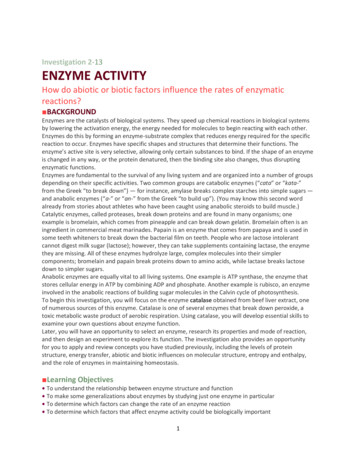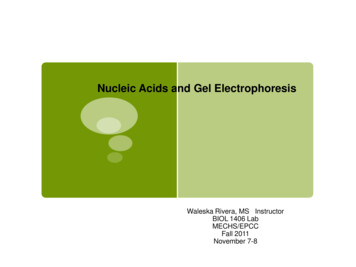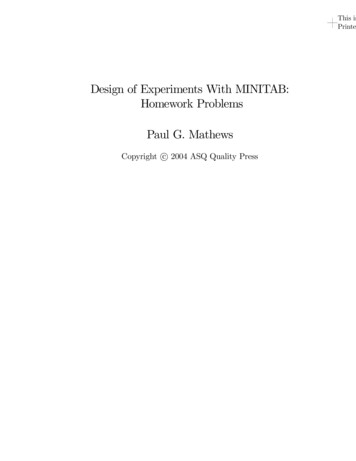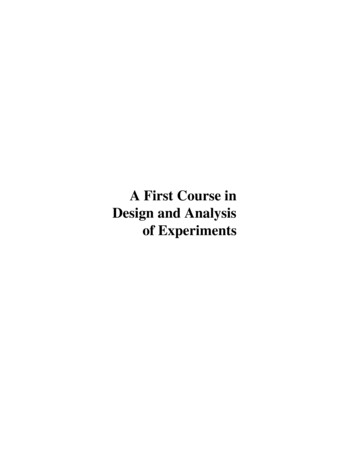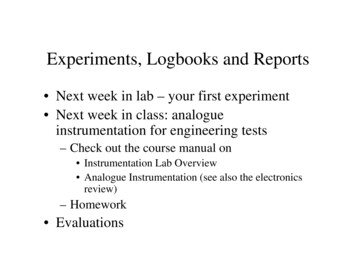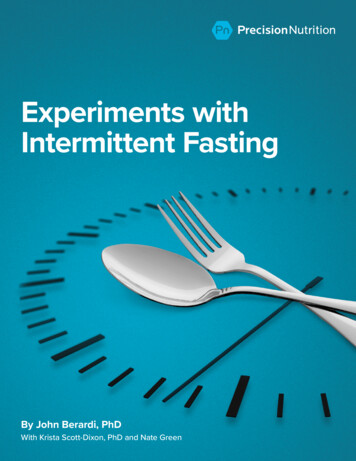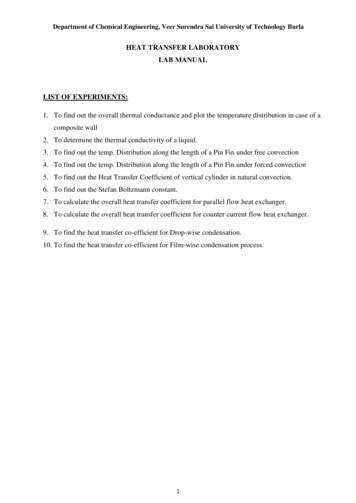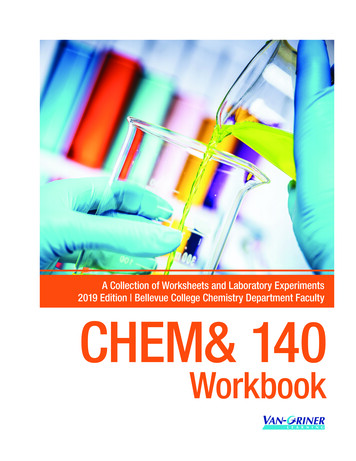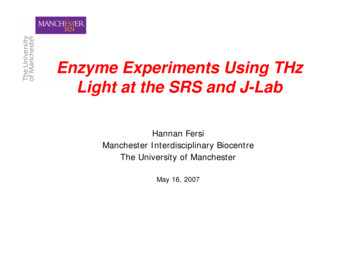
Transcription
Enzyme Experiments Using THzLight at the SRS and J-LabHannan FersiManchester Interdisciplinary BiocentreThe University of ManchesterMay 16, 2007
Feasibility StudyCan high power THz radiation be used to searchand to probe low frequency protein vibrationsthat facilitate quantum tunnelling of hydrogen inenzyme systems?
IntroductionThe physical basis of the catalytic power of enzymesremains contentious despite sustained and intensiveresearch effortsOur knowledge of enzyme catalysis is predominantlydescriptive and gained from traditional proteincrystallography and solution studiesThe question of whether enzymes have evolved to usequantum tunneling to the best advantage has provokeda heated debate in the Life Sciences
Enzyme mechanisms: Where are we at?-Good appreciation of reaction mechanisms in theterms of bond making/breaking i.e. ‘pushing’electrons around-Good appreciation of enzyme structure and staticview of mechanism inferred from structural biologyapproaches
And if we are lucky .Time-resolved structural methods identifyshort-lived (in solution) reaction intermediates
Less clear – a detailed physicalpicture of catalysis Rate accelerations up to 1018 over referencereaction in absence of an enzyme Current physical models (e.g. TST) onlyaccount for 106
What’s missing? Protein dynamics that modulate the barrier to thereaction and couple to the reaction coordinate Chemical identification of fleeting intermediatese.g. radical species
How do enzymes achieve highcatalytic rates?Small-scale promoting vibrations/motions are likely topromote H-transfer and electron transfer by quantumtunneling mechanisms. Probably also true for over-thebarrier mechanisms
Now established that H-transfer by quantum tunneling iswidespread in biology Controversies remain in the field – how does tunnelingbarrier compression facilitate the tunnelling process Motions in the ES complex occur on the sub picosecondtimescale. Need to identify motions coupled to the reactioncoordinate – needs new experimental methods With a few exceptions we are almost entirely reliant oncomputational methods to identify this type of fast motion
Environmentally coupled/vibrationallyassisted H-tunnelling model New theory is emerging to rationalise role of small-scalevibrations in driving enzyme catalysis Passive dynamics – no ‘compressive’ motion on the Htransfer coordinate. Yields temperature independent KIE Active dynamics – a promoting vibration compressesthe HC coordinate, narrowing the tunneling barrier topromote tunneling. Yields temperature dependent KIE. Active dynamics on sub-picosecond timescale
Aromatic Amine Dehydrogenase (AADH)AADH is the most extensively characterised enzymeinvolved in H-tunnelling (computationally)In the case of the AADH system the promoting vibrationoccurs at 165 cm-1That’ s where THz radiation comes in!!
Why we need High Power THZ light Spectral investigations are being carried out on a variety ofsignificant biological samples to understand the interaction offar-infrared (FIR) and THz radiation with biological systemson a molecular level, i.e. on the basis of resonant processeswith:-Electronic- vibrational- and rotational states of complex biological molecules
Why we need High Power THZ light 1 – 10 THz region of the electromagnetic spectrum isparticularly difficult to access experimentally due to the lowintensity of conventional laboratory based sources There is a general interest in developing a new researchfield linking new powerful sources of THz radiation with keycontemporary challenges in protein science Specifically, the highly controversial role of fast proteinpromoting vibrations in biological catalysis
Manchester Interdisciplinary Biocentre (MIB)University of ManchesterDr. Peter Gardner, surface analysis using IR techniquesDr. Nigel Scrutton, mechanisms of redox enzymes *Dr. Mike Sutcliffe, mechanistic and computational enzymology *Nature 431, 396-397, 2004 *Science (Masgrau et al., in press)*CLRC DaresburyDr. Mark SurmanDr Gwyn Williams at the Jefferson Laboratory
Experimental ApproachSRS Beamline 13.3Station designed forsurface scienceInvestigations of lowfrequency adsorbatemodesMartin-Puplet step-scan interferometer
P. Gardner recorded spectra down to 100 cm-1SnCl4 at 120 Kν4101.00SnBr4 at 120 Kν3101.00100.00355100.00355% Reflectance99.00% enumber / cm-160070091.00200250300ν3350400450Wavenumber / cm-1500
Good sensitivity to detect single monolayers100.00100.00% 350400450500-1Wavenumber / cmMost sensitive far-IR beamline built!
Infrared Extraction from the SRSCollect 60 x 60 mRadClose-in mirror1 m from tangent pointhigh x-ray power loadThe idea!!With minor modifications the station13.3 will be converted into adedicated THz test facility to see ifit is possible to detect the promotingvibrations
Aim on the study Reconfigure THz test facility to incorporate the second opticalbench optimised for 100 – 300 cm-1 region and commission thissystem Obtain a high resolution spectrum from AADH in the 10 – 300 cm-1region to characterise modes in different forms of AADH toidentify the modes important in the H-tunnelling reaction Pump probe these modes to identify which of these motions act asrate promoting vibrations for the H-tunnelling reaction Life-time analysis of promoting mode(s) in active enzymesubstrate complex and inactive enzyme-substrate analoguecomplex as further evidence for a role for vibrations in the Htunnelling reaction
Sample preparation for solidsThe compounds were mixed with PET or PTFE powder and grind toreduce particle sizeThe IR pellets were made up into a 13 mm diameter, self supportingpressed disc, with a 0.5 mm to 1 mm thickness using 2 ton pressureBackground spectrum of pure PET or PTFEAll the spectra were collected in the range of 1000 to 25 cm-1 (0.5 cm-1resolution)
Sample preparation for solutionsBovine serum albumin (BSA) is our representative biomoleculeBSA is a monomeric protein of molecular weight 66.4 kDa and shares76% sequence homology with human serum albuminIts PDB code is 1AO6 (Huang et al. 2004)Proteins solutions will be made by dissolving X mg of lyophilized powdersof proteins X into Tris buffer at pH 7.0.Homogeneity of the solutions is critical for THz measurements sothe solutions will be sonicated for 1 h to fully dissolve aggregates.The solutions will be injected into the FTIR cell
Sample preparation for solutionsOne cell for different pathlengths: Rotation of the main body alters thepathlength of the cell over a range of0 mm to 6 mm with scale division of5µm The windows do not rotate in relation tothe body movement and hence maintainparallelism throughout the pathlengthrange Easily increase pathlength toobserve minor bands
Uric acid THz spectraThe first test spectra using the THz test facility on theSRS for THz spectroscopy were recorded on uric acid inorder to try to reproduce data obtained in the THzBridge program.Uric acidUric acid spectrum obtainedusing THz time domainspectroscopy from solid pelletsTaday et al
Spectrum of uric acid and allantoin at 0.5 cm-1 spectralresolution277 cm-1163 cm-1297 cm-1144 cm-1133 cm-148 cm-1215 cm-180 cm-1
47.9 cm-1Absobance79.6 cm-140.2 cm-1Gardner et al1.01.52.02.53.0Frequency / THzTaday et al
Bovine Serum Albumin (BSA) THz spectraJing Xu, Kevin W. Plaxco and S. James Allen2006 15: 1175-1181 Protein Sci.2.0BSA/PTFE 20/80 %(w/w)Nic0218new.spaAbsorption1.5BSA/PTFE 50/50 %(w/w)Nic0253new.spa1.00.50.01.01.52.0Frequency / THz2.53.0
Summary Station 13.3 has been converted into a working THzspectroscopy test facility We obtained THz spectra of uric acid, allantoin,L-glutamicacid, L and D glucose, sucrose, tryptamine and BSA. First tests suggest that it is working as well if not better thanexpected First experiments with small molecules and BSA at highresolution are consistent with previous work and veryencouraging. Still early days
Goal for our first visit at J-Lab Reproduce THz spectra of simple solids and BSA Do preliminary studies of small molecules and proteins insolutions The signal-to-noise ratio in the spectrum is likely to be poorin this region so optimisation of pathlength/solvent/concentration etc. Does THz light at J-lab damage our samples? What areour limitations? Should we use a flow cell?
Future work at J-lab THz facility at the Jefferson Laboratory is the mostpowerful since it can deliver both high peak power andhigh repetition rate Obtain THz spectra of more solid proteins and proteinsin solution Identify band at 165 cm-1 in AADH system Carry out pumping experiments at J-Lab and attempt toinfluence reaction rates
Acknowledgements Manchester Interdisciplinary Biocentre, University of ManchesterDr. Peter GardnerDr. Nigel ScruttonDr. Mike Sutcliffe CLRC DaresburyDr. Mark SurmanDr. Terry LeeTechnical Staff Jefferson Laboratory, FELDr Gwyn WilliamsEPSRC Physics at the Life Science Interface
Our knowledge of enzyme catalysis is predominantly descriptive and gained from traditional protein crystallography and solution studies . Enzyme mechanisms: Where are we at? - Good appreciation of reaction mechanisms in the terms of bond making/breaking i.e. ‘pushing’ electrons around - Good appreciation of enzyme structure and static view of mechanism inferred from structural biology .

